This article is written for solo female travelers visiting Madagascar as part of our women-only tour or on their own.
You will find a brief history of the country, tips for the best time to visit, travel essentials and entry requirements, health and safety advice, and some local culture, from basic Malagasy and French vocab to the best foods and drinks to try.
I have also included a reading list, and a few movies and shows to watch to immerse yourself in the culture.
Looking for what to pack? You can find our Madagascar packing list here.
So, let’s move it, move it! (If you know, you know)
Intro to the history of Madagascar

Madagascar is an isolated island in the Indian Ocean, just off the southeast coast of Africa, across from Mozambique.
It’s the fourth-largest island in the world, so it’s not a small country, but it is quite remote, and has never experienced much tourism.
Yes, this is Africa, but its isolation from the continent has seen a unique ecosystem and culture develop, distinct from the mainland, that has not been shaped by the same historic and cultural influences as other African countries.
Geologically, Madagascar’s story starts around 165 million years ago when the landmass broke away from Africa, and then later from India (about 88 million years ago).
It was essentially a piece of land that broke off from two continents, left to float on its own and evolve in parallel but separately from the rest of the world.
For anyone who’s seen the DreamWorks Animation film of the same name, the island became a living laboratory where evolution ran wild. That’s why today, nine out of ten plant and animal species here are found nowhere else.
Before humans ever set foot, lemurs ruled the treetops, giant birds the skies, and chameleons perfected their camouflage game.
The human chapter began surprisingly late.
Unlike mainland Africa, Madagascar wasn’t settled until roughly 1,000–1,500 years ago. And here’s the twist: the first arrivals weren’t from nearby Mozambique but from far-flung Southeast Asia.
Austronesian sailors stumbled onto the island while steering outrigger canoes across the Indian Ocean, carrying rice, bananas, and their musical bamboo instruments. A few centuries later, Bantu-speaking people from East Africa joined them, bringing cattle, iron-working, and new traditions.
The blend of these two worlds shaped the Malagasy people, which today is a mix of both African and Asian heritage, traditions, and food sprinkled with European influence through brief colonisation.
Over time, distinct ethnic groups formed across the island’s regions; Merina in the central highlands, Betsimisaraka along the east coast, Sakalava in the west, and many others. Each group held onto its own customs while sharing a unifying Malagasy language (though French is the language spoken primarily today).
Storytelling, poetry, and ancestral rituals like famadihana – the “turning of the bones” – became cultural cornerstones.
By the Middle Ages, Madagascar was a permanent part of Indian Ocean trade networks.
Arab and Swahili merchants dropped anchor on its coasts, and would exchange beads, cloth, and firearms for slaves and spices. You’ll see their influence in Malagasy vocabulary, astrology, and even architecture still today.

The 17th and 18th centuries brought more dramatic characters: pirates.
The island’s bays, especially Île Sainte-Marie, became famous for outlaws like Captain Kidd. Local legends mix fact and folklore, but it’s true that Madagascar offered both safe anchorage and opportunities for mischief.
By the 19th century, power began to centralize.
The Merina Kingdom, based in the highlands around Antananarivo, rose under kings like Andrianampoinimerina and Queen Ranavalona I. They expanded their reach across the island, resisted foreign incursions, and set up complex political systems. Ranavalona is remembered as both a fierce defender of independence and a ruthless ruler, depending on who tells the story.
NOTE: King Julien XIII is not a real historical king in Madagascar; he is a fictional, self-proclaimed ring-tailed lemur king from the Madagascar film franchise, though the species he represents is real and endemic to the island.
Foreign powers were never far behind. The French slowly tightened their grip, turning Madagascar into a colony in 1896.
Plantations, forced labor, and the extraction of resources (the trademarks of colonisation) followed, while Malagasy resistance simmered below the surface.
During World War II, the island became a strategic pawn until Free French forces took control in 1942.
Madagascar became Independent in 1960.
Despite the locals’ enthusiasm for steering their own future, the decades since independence have been turbulent, marked by coups, economic struggles, and a push for democracy.
Through all of this though, Malagasy culture has held strong, and visiting today means being able to experience history not only in museums or books but in the songs sung at village gatherings, in the red earth of the highlands, and in the way people speak about their ancestors as if they’re still part of the family.
What Madagascar hasn’t experienced in history, is a full, widespread industrialization like that seen in the traditional Industrial Revolutions of other countries. So accessibility and infrastructure is something the country still very much needs to develop.
Madagascar History at a Glance

Madagascar’s history doesn’t read like a straight line, but we have put it into a rough timeline so you can see the development of the country at a glance.
- 165 million years ago – Madagascar splits from Africa; later drifts away from India around 88 million years ago. Nature runs the show, creating today’s quirky, one-of-a-kind wildlife.
- Around AD 500–700 – Austronesian seafarers arrive from Southeast Asia, planting rice, bananas, and their cultural roots.
- 9th–10th centuries – African Bantu groups reach the island, bringing cattle herding, iron skills, and fresh traditions.
- 1100s–1400s – Arab and Swahili traders stop along the coasts; Madagascar joins Indian Ocean trading routes.
- 1600s–1700s – Pirates, including the infamous Captain Kidd, shelter in bays like Île Sainte-Marie.
- Late 1700s–1800s – The Merina Kingdom rises in the central highlands, uniting much of the island under rulers like Andrianampoinimerina and Queen Ranavalona I.
- 1896 – France claims Madagascar as a colony; plantations and forced labor reshape life.
- 1942 – During World War II, Free French forces seized the island from Vichy France.
- 1960 – Madagascar celebrates independence, raising its own flag for the first time.
- 1970s–2000s – Political ups and downs, coups, and reforms keep the nation in flux.
- 2005 – The animated DreamWorks hit Madagascar is released, with dancing lemurs and city animals escaping to the wild. While not accurate, it did put the island’s name on the global stage and sparked curiosity about the real place.
- Today – Malagasy culture and traditions remain strong
Quick facts about Madagascar
We’ve already made the point that Madagascar is a unique country, so here are some unique facts.
1. The fourth-largest island in the world. Madagascar is huge. It’s about the same size of France and nearly twice the size of Arizona. It’s bigger than Spain, Italy, or Thailand, and that’s why each region feels like a different country.
The island stretches over 1,500 km from north to south, which means traveling around takes time. Don’t expect to “do” Madagascar in a week; distances and rough roads make every journey an adventure.
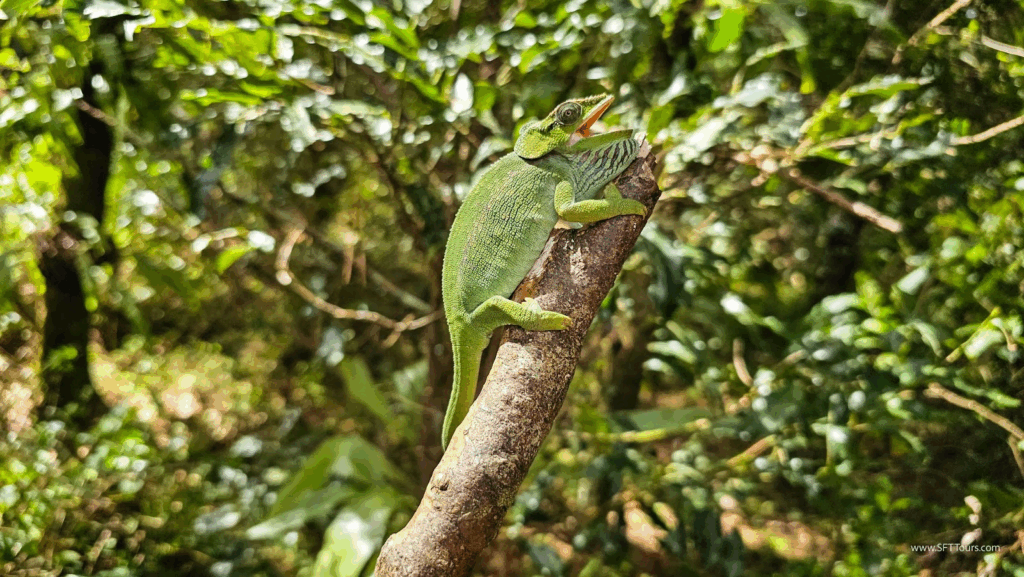
2. 90% of its wildlife is found nowhere else. Quite like our tour of Ecuador and the Galapagos, if you’re here for animals, you’ve hit the jackpot. From wide-eyed lemurs to chameleons that change color like mood rings, Madagascar’s isolation created creatures you literally can’t see anywhere else. Biologists call it a “living laboratory” of evolution.
3. Roads are rough and slow. Distances on a map look short, but a 200 km trip can take an entire day. Potholes, mud, and occasional zebu carts on the road mean you’ll need both patience and also a sense of humor while traveling around the country. As we mentioned, infrastructure is lacking, and that is especially true of the roads.
4. Cyclone season can get intense. From January to April, cyclones sweep across Madagascar’s east coast. Heavy rains and strong winds sometimes cut off villages and wash out roads, so travelers either avoid this season or stick to inland routes.

5. The island is famous for its baobab trees. Baobabs look like they’ve been planted upside down, with roots sticking into the sky. In places like the Avenue of the Baobabs, these giants line the road like guardians, especially magical at sunrise and sunset.
There’s even a “lover’s baobab”; near Morondava, two baobabs are twisted together in a permanent hug. Locals call it Baobab Amoureux, and it’s become a romantic stop for couples traveling through the west.
6. Whale watching is unforgettable. Every June to September, humpback whales migrate along Madagascar’s coasts, especially near Île Sainte-Marie. Locals run small boat trips, and you’ll see them breach and slap their tails in the ocean.
7. December is prime for diving. Madagascar’s coral reefs shine during December when waters are calm and clear. Spots around Nosy Be and Ifaty mean you can see rainbow-colored fish, turtles, and maybe even a whale shark cruising by.
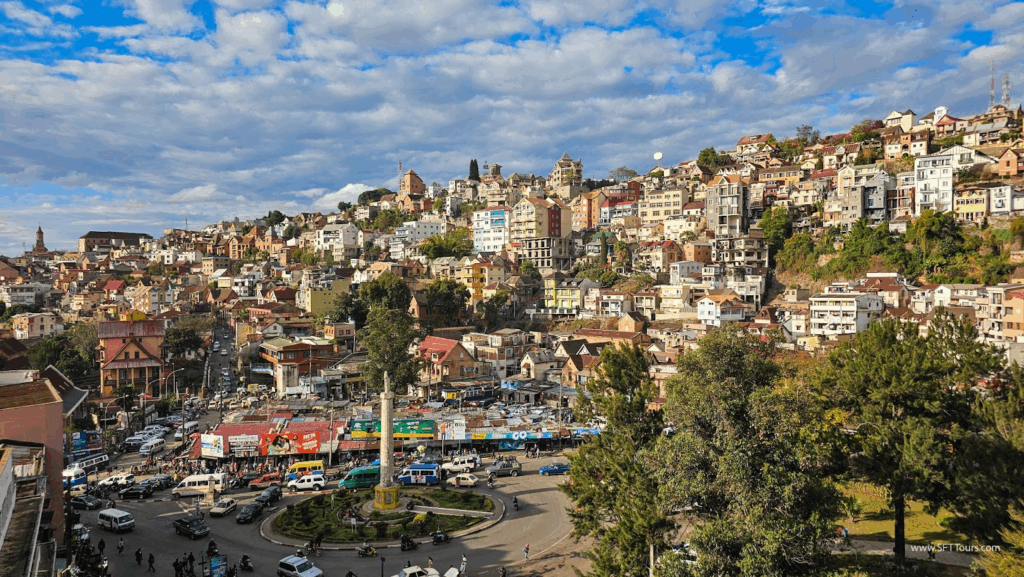
8. The capital is Antananarivo – Tana for short. Antananarivo sits high in the central highlands and is home to over a million people. The city is a mix of steep cobbled streets, old royal palaces, French colonial architecture, and modern bustle. Most visitors fly in and out here.
9. Malagasy and French are the official languages. Malagasy is spoken everywhere, though each region has its own dialect. French lingers from colonial times, especially in schools and government. English isn’t widespread, so learning a few Malagasy words will win you big smiles.
10. The currency is the Malagasy Ariary (MGA) Cash is king here, especially outside big towns. One U.S. dollar is worth thousands of ariary, so get used to carrying wads of notes and double-checking the zeros.

11. The valiha is the national instrument. This bamboo tube creates a bright, harp-like sound. You’ll hear it at village gatherings and sometimes in hotels during dinner. It’s an instrument that has been passed down through generations.
12. People drive on the right-hand side If you’re renting a car, know that Madagascar follows right-hand traffic like most of the world. That said, roads are tricky, so most travelers prefer to hire a driver with a sturdy 4×4.
13. The time zone is East Africa Time (UTC+3) No daylight savings, no confusion. Just a steady three hours ahead of London and seven ahead of New York. It makes planning calls home or syncing flights much simpler (though we don’t recommend working on this trip – see below for our advice on connectivity).

14. Madagascar belongs to the lemurs. There are over 100 species, from tiny mouse lemurs to the ring-tailed stars of nature documentaries. Sadly, many are endangered, but visiting national parks supports conservation. Expect that lemurs will be jumping on your shoulders, and stealing food like bananas; animals here are curious, bold, and sometimes a little cheeky.
15. Mosquitoes are relentless fans of visitors. Bring repellent, long sleeves, and maybe even a mosquito net. While lemurs might ignore you, the bugs won’t. Malaria is present, so prevention is smart travel.
Madagascar travel tips
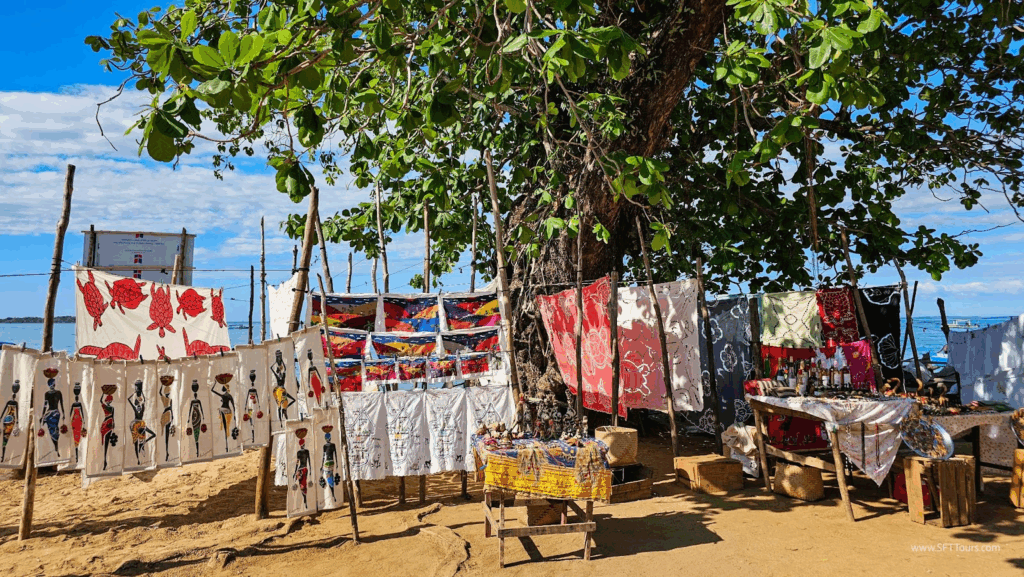
In this section, we will discuss various travel tips that will come in handy during a visit to Madagascar.
When to visit
The best time to visit Madagascar is May to October, during the cool dry season.
Madagascar doesn’t run on the classic four-season calendar. Instead, the island swings between two distinct moods: hot and rainy, or cool and dry.
Which one you prefer depends on what you want out of the trip, and how much mud you’re willing to put up with. Personally, we plan our women only tour for October, and highly recommend independent travelers avoid the monsoon season.
Hot & Rainy Season (November to April)
This is when the tropics turn on full blast. Days are steamy, storms roll in fast, and the eastern coastline often takes a pounding from cyclones, especially between January and March. Travel to Magadscar is already tough enough, but during these months roads can be completely washed away, and villages sometimes entirely cut off.
The landscapes do go an amazingly lush green though, and it’s the prime window for spotting baby lemurs. Divers and snorkelers still head north to Nosy Be or west to Tulear before cyclone risks peak, and if you don’t mind the extreme heat and disruption from rain, you’ll have national parks and beaches mostly to yourself.
Cool & Dry Season (May to October)
In our opinion this is Madagascar’s sweet spot, where the wildlife, landscapes, and weather all line up. The air cools, the rains ease, and suddenly the country feels more accessible. Roads are passable, skies are clear, and the highlands have fresh, crisp mornings.
From June to September, humpback whales swim past Île Sainte-Marie, breaching and tail-slapping in plain sight from the shore. It’s also the perfect weather for hiking in parks like Isalo or Andasibe, where lemurs and chameleons are easier to spot without dense foliage in the way from the rainy season’s growth. Later or earlier in the season it is also better for chameleon spotting as it is less cold.
Shoulder Seasons
April and November straddle the two seasons, so either of these months can be a good choice if you’re looking for fewer tourists, and lower prices. There will definitely be showers, though you should also still have bright days and lively landscapes. These months can be a pretty good way to balance affordability and adventure.
Public holidays and festivals in Madagascar
These holidays are celebrated nationwide, with many businesses closed, especially on major religious holidays.
- New Year’s Day – 1 January
- Alahamady Be (Malagasy New Year) – Usually in March or April (date shifts with lunar calendar)
- Martyrs’ Day – 29 March
- Santabary (First Rice Harvest Festival) – Celebrated at the end of the harvest season, around April or May
- Labour Day – 1 May
- Independence Day – 26 June
- Famadihana (Turning of the Bones) – July to September (timing varies by family and region)
- Whale Festival (Festival des Baleines, Île Sainte-Marie) – Typically late June or July
- Assumption of Mary – 15 August
- All Saints’ Day – 1 November
- Christmas Day – 25 December
Passport and visa requirements

Regardless of nationality, everyone needs a visa to enter Madagascar, and this can be done online in advance, or at the airport upon arrival.
The only official, government-run platform for applying online is evisamada-mg.com.
The prices of the online visa are the same as those paid on arrival, and range from $10 – $45 USD depending on the length of your stay (see the website for the full price list).
eVisa Online: Madagascar offers a streamlined eVisa system that lets you apply online before travel. It typically supports tourist stays of 15, 30, 60, or 90 days, and is emailed to you as a PDF. We recommend applying at least 1-2 weeks ahead of time to allow for any delays.
Visa on Arrival: We always prefer to be prepared with an eVisa in advance, but you can also get a “visa on arrival” at the airport, and this is available at most major entry points like Antananarivo, Toamasina, Tuléar, and Antsiranana. It’s essentially the same as the eVisa but done in person, there’s no difference in price to do it on arrival.
Passport Validity: Make sure your passport has at least 6 months of remaining validity beyond your planned stay and at least one blank page for entry stamps (this is pretty much a universal requirement).
Health and safety

Bring all the medication you’ll need + a first aid kit: Madagascar is remote, and isolated from the typical level of supply you may be used to. Especially as you travel into more remote regions, you may end up being quite far from a doctor or pharmacy, so we strongly recommend to bring all prescription medication you may need, enough to last you the entire trip, as well as a first aid kit with basic essentials that will allow you to tend to minor injuries like cuts, scrapes and sprains from outdoor adventure.
IMPORTANT: Make sure any prescription medication comes in its original pharmacy packaging, and with the corresponding doctor note and prescription to avoid issues at the border. It is your responsibility to check that whatever medication you bring can indeed be taken into Madagascar. What may be legal in your country, or even sold over the counter, could be a controlled substance elsewhere. You should always check before the trip with the corresponding Madagascan body.
Female Sanitary Health: Pads may be hard to find and tampons are non-existent in Madagascar, so bring enough of your favorite brand to last you the duration of your trip.
Get that coverage: We never leave the house without purchasing extensive medical and travel insurance coverage and this is why we make it mandatory to join our tours. You should make sure that you have adequate medical insurance to cover any unforeseen medical expenses.
Ultimately, medical facilities in Madagascar are basic. You’ll need to be evacuated if you become seriously ill or injured, and all hospitals require up-front payments, and private clinics can be expensive.
The best travel insurance will differ for each traveler, depending on the nature, style, and length of your trip, so we recommend using an aggregator and comparison tool such as Travel Insurance Masters to find the right one for you depending on what coverage you want, age, location, trip, etc.
In case of emergency call:
- Ambulance – 211-70
- Police – 117, 229-72
- Ministry of Tourism – 262-98 (Antananarivo), 227-00 (Antsiranana), 228-72 (Mahadzanga), 335-91 (Tuamasina), 414-59 (Tulear), 507-67 (Fianarantsoa).
Tap water: Tap water is not safe to drink, and locals themselves often boil or filter their water. Foodborne, waterborne and other infectious diseases (including cholera, hepatitis and schistosomiasis) are common, so it’s extremely important to only drink treated or bottled water, to avoid raw or undercooked food, and swimming in freshwater.
The tap water isn’t treated to international standards, and contamination from bacteria, parasites, and even industrial run-off is common, especially in rural areas. The risks aren’t just about an upset stomach, it’s very easy to contract illnesses like giardia or hepatitis A.
Brushing teeth with bottled or boiled water is smart too, as even a splash from the tap can cause trouble. Ice is best avoided unless you know it’s made from safe sources.
A water purifier bottle from Grayl is your best bet for maintaining safe drinking water. I have used it in more than 15 countries to turn tap water into drinking water. Bottled water is available in Madagascar but plastic rubbish is a real issue and tap water is not drinkable.
We also recommend traveling with electrolytes or rehydration tablets you can add to your water. I like to bring these hydrating tablets from Nuun with me, always. They come in handy if you end up with travelers’ diarrhoea where the risk of dehydration is high.
Mosquitoes are a real problem in Madagascar, so it’s important to pack repellent, long sleeves, treat your clothes with permethrin and maybe even a stylish hat they can’t bite through. Malaria is present, so we recommend consulting a travel doctor about prevention before you go.
Everyone has their favorite repellent, from the natural repellents that use citronella and other ingredients to the DEET-based repellents. If you decide to use DEET-based repellent, beware that it is a toxic chemical and you should apply it in an airy place and wash your hands thoroughly to avoid having an upset stomach (from then touching your mouth).
If you buy repellents with a high concentration of DEET (eg. over 50%) beware that their chemicals may melt plastic, including the bag which you may store them in or your sneakers (yep, true story)!
I prefer to spray repellent on my clothes instead of on my skin. I have relied on the brand Repel at home in Singapore and in the bush and tropical jungles for years, and it always works.
Vaccinations: There is a high exposure risk to diseases here, so it’s important to make sure your vaccinations are up to date. If you are coming from an endemic Yellow Fever area or transition through one for more than 12h, you should make sure you have taken your Yellow Fever shot as it is mandatory to enter the country. This includes coming in from Ethiopia or Kenya or transiting through either for more than 12h.
Safety in Madagascar for solo female travelers
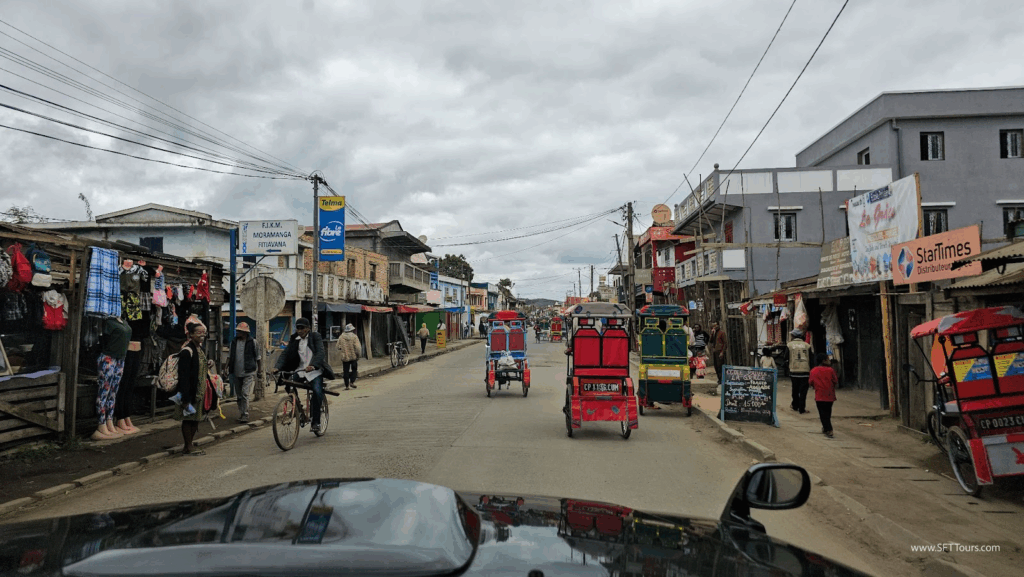
When we conducted our first Solo Female Travel Survey, one of the most relevant take-aways was that women who travel solo unanimously worry about their personal safety.
The best countries for first time solo female travelers all have safety in common. That’s why we created the first and most complete resource for women who travel solo to find safety information by country or destination.
With safety data coming from the US and UK Travel Advisories and the Global Peace Index, the index considers factors like the risk of theft, scam and harassment, as well as analyzing attitudes towards women in each country to rank each country from 1-4, 1 being the safest and 4 being the most dangerous for solo female travelers.
Crime, including violent crime, can be an issue in Madagascar’s urban areas, and so it’s important to travel with a heightened sense of awareness, and plan in advance for preventative measures against petty crimes like bag-snatching and pickpocketing, which are common.
Being prepared with gear like an antitheft bag (see our recommendations here), and a phone lanyard (I have this one) are super useful in Madagascar; we consider them a safety and self defense tool and the most efficient way to reduce the risk of pickpockets and theft.
The cyclone season is from November to April, and if you’re traveling at this time it’s extremely important to be aware of the risk of heavy rain, flooding, strong winds and landslides. Check weather conditions when planning your travel and monitor local media for weather forecasts and warnings.
Protests occur regularly, particularly in periods near elections. Avoid demonstrations and large public gatherings. Follow the advice of local authorities. Read more of our tips about staying safe during protests here.
Road conditions are the other safety risk to consider in Madagascar; an adventure in themselves, complete with potholes, unpredictable traffic, and journeys that take twice as long as you’d expect. Hiring a 4×4 with a local driver isn’t just convenient, it’s often the safest option, especially if you’re traveling alone.
We do recommend traveling with motion sickness patches, and if you are prone to motion sickness you’re absolutely going to feel it. Many of the guests on our tours use motion sickness patches, and they spend a week without getting sick.
Same-sex relationships are legal for people over 21 but same-sex marriage isn’t recognised. Same sex relationships are not widely accepted in Madagascar, so it may be best to avoid public displays of affection.
Travel essentials for Madagascar
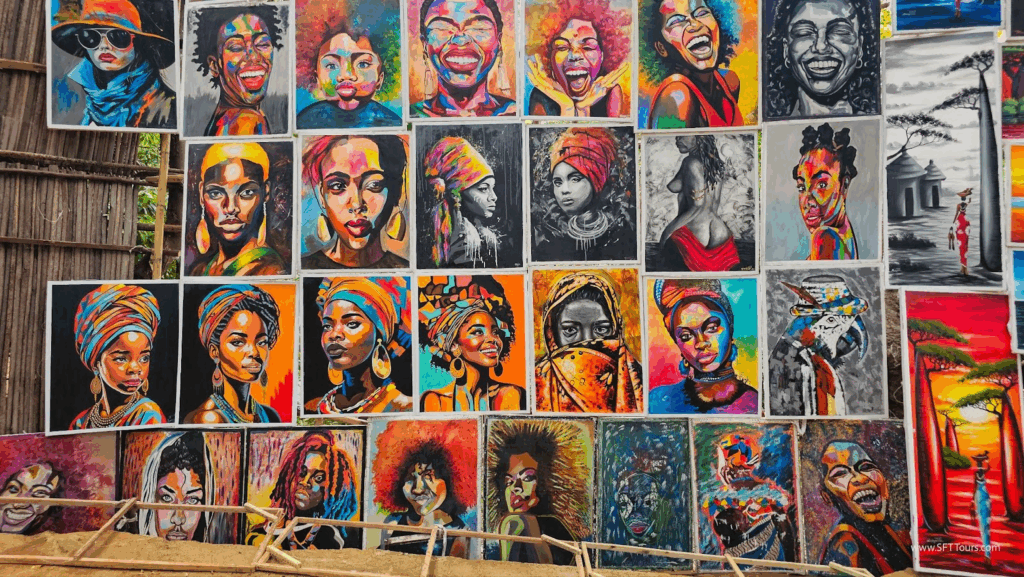
In this section we will look at a range of other things to consider when traveling to Madagascar as a solo female traveler.
Madagascar plugs

Madagascar uses European-style plugs: type C and E, with two round pins. A universal adapter should cover you; I love this one because it has USB ports for all the electronics I now carry.
Bonus points for power banks if regional power dances on and off. This Anker Portable Charger has a 20000mAh capacity, and fast-charging USB-C ports, you can power up your devices in a flash, while the LED display keeps you in the know about your battery level.
Staying connected: Public free WiFi
Urban cafés and fancier lodges might have Wi‑Fi, but rural areas are hit or miss (that’s the kindest way to put it).
A local SIM (Orange is often the most reliable) will tether you to maps, messages, and your mother checking in.
We don’t recommend relying on WiFi while you’re in Madagascar, and you shouldn’t expect to work or connect to meetings on the networks. If you’re connecting to an unsecured, open network, secure your connection by using a VPN (Virtual Private Network – essential for internet safety).
Money and Currency

The official currency in Madagascar is the Malagasy Ariary (MGA), and it’s one of the few currencies in the world that’s not pegged to another.
The notes are colorful, often featuring lemurs or baobabs, but don’t let the designs distract you from the zeros. Ariary comes in large denominations, and it’s easy to hand over the wrong bill if you’re not paying attention.
Cash is king in Madagascar, and outside of Antananarivo and a handful of bigger towns, you can’t rely on ATMs or card machines.
Even in cities, machines sometimes run out of cash or simply don’t work. ATMs are usually found at major banks like BNI, BOA, and BFV-SG, and they’ll dispense only ariary, not foreign currency.
Carrying enough cash for rural travel is essential, and always try to keep a stash of small notes, because shopkeepers and taxi drivers often won’t have change for larger bills.
Tipping isn’t expected, but a few ariary in a service situation will always be appreciated.
Credit cards: Credit cards are slowly becoming more accepted in Madagascar, but the reality is they’re still limited to top-end hotels, international restaurants, and some travel agencies. Visa is the most widely accepted, followed by MasterCard. American Express is rarely accepted.
Even when cards are accepted, expect a surcharge of 3-5% on top of your bill, as fees are passed directly to the customer.
Personally, we wouldn’t recommend relying on cards as your main payment method. Keep one with you as a backup for large expenses, but always have enough cash to cover basics, and withdraw more than you think you’ll need before heading into rural areas.
Basic Madagascan words to know

Madagascar has two official languages; Malagasy, heard in every village and market, and French, a leftover from colonial times.
English is rarely spoken, so here are a few words before you go, along with their pronunciations:
In Malagasy (with pronunciation)
- Hello – Salama (sah-LAH-mah)
- Good morning – Salama maraina (sah-LAH-mah mah-RAI-nah)
- Good afternoon – Salama tolakandro (sah-LAH-mah too-lah-KAN-droo)
- Good evening – Salama hariva (sah-LAH-mah hah-REE-vah)
- Good night – Tafandria mandry (ta-fan-DREE-ah MAN-dree)
- Thank you – Misaotra (mee-SOW-trah)
- You’re welcome – Tsy misy fisaorana (tsee MEE-see fee-sow-RAH-nah)
- Please / Help – Azafady (ah-zah-FAH-dee)
- Sorry / Excuse me – Azafady (ah-zah-FAH-dee)
- Excuse me (to pass by someone) – Miala tsiny (mee-AH-lah TSEE-nee)
In French
- Hello – Bonjour (bon-ZHOOR)
- Good morning – Bonjour (bon-ZHOOR)
- Good afternoon – Bon après-midi (bon ah-PRAY mee-DEE)
- Good evening – Bonsoir (bon-SWAHR)
- Good night – Bonne nuit (bun NWEE)
- Thank you – Merci (mehr-SEE)
- You’re welcome – De rien (duh ree-EN)
- Please / Help – S’il vous plaît / Aidez-moi (seel voo PLEH / eh-DAY mwah)
- Sorry / Excuse me – Pardon / Excusez-moi (par-DOHN / ex-KYOO-zay mwah)
- Excuse me (to pass by someone) – Pardon (par-DOHN)
Local Cuisine
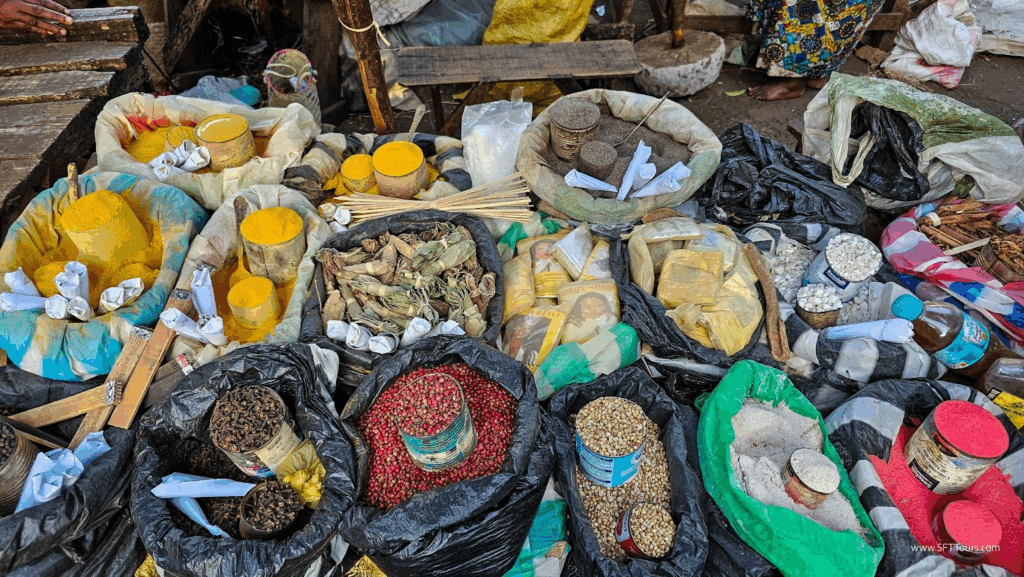
It’s important to know when visiting Madagascar, that a) rice is life, and you’ll eat it at almost every meal, and b) the cuisine here is fiery and well seasoned.
Locals will often test your bravery by handing you a spoonful of chili paste on the side, just as Australians get a kick out of torturing visitors with Vegemite.
We recommend smiling, taking a tiny taste, and you’ll earn respect (and maybe a tear or two). But there are many milder food staples across the country too.
As an island that is famous for spices, you will find that food in general is well seasoned, besides being spicy. Historical trade with Asia and Zanzibar brought many spices that made the local cuisine extra rich and complex.

Madagascar is a well known exporter of pepper and the world’s largest exporter of vanilla beans, which is the second most exported product out of the country.
In addition to local and regional food influences, French cuisine and techniques can be seen in Malagasy dishes, especially in the capital, where French and fusion restaurants abound. Bread, especially the baguette-type, are also commonplace, and flaky pastries are a staple in Madagascar like in many other former French colonies.
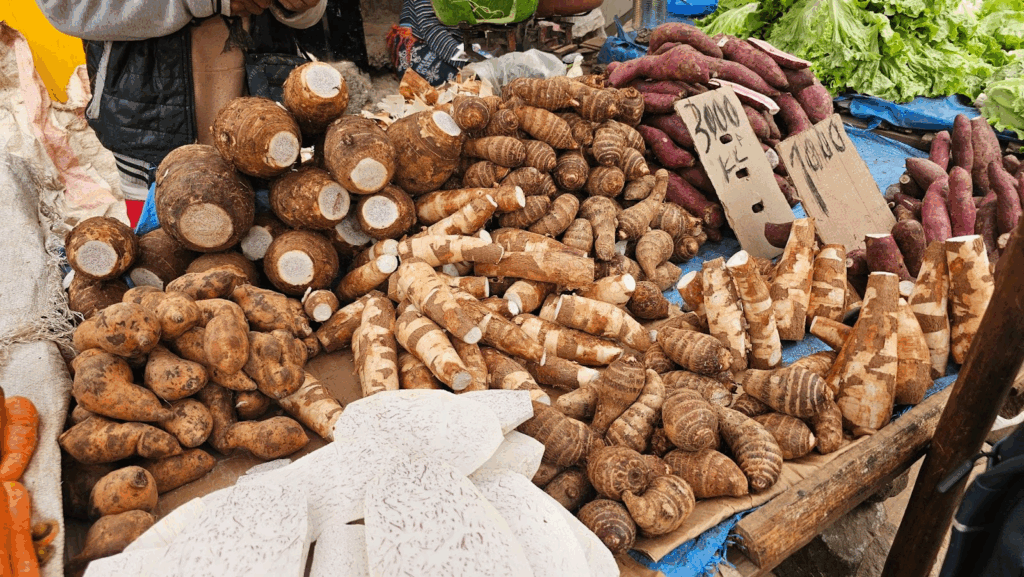
Besides rice, other root vegetables such as sweet potato, taro and cassava are largely found and eaten in the country so you can expect to find them as side dishes.
Best Foods to try in Madagascar
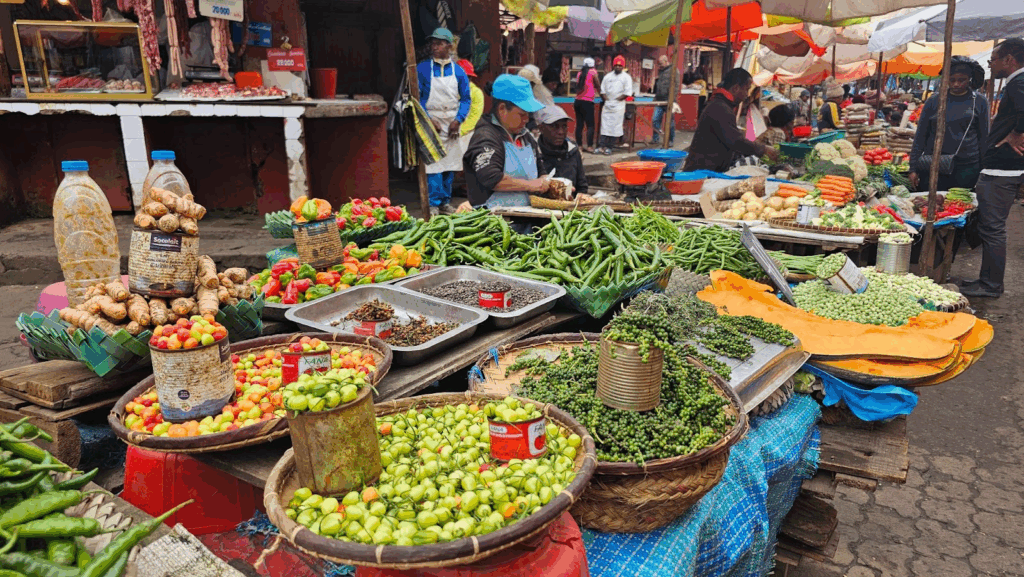
Laoka + Vary Rice is life in Madagascar, and locals eat it three times a day. But rice never comes alone, it’s often paired with laoka, which is a side dish that might be fish, beans, zebu (local cattle), leafy greens, or even dried shrimp.
So, Vary is the staple (rice), and Laoka is the accompanying side, which could be a garlicky beef stew one day, and a handful of sautéed vegetables with chili.

Ravitoto is cassava leaves pounded into a rich green paste, then slow-cooked with pork chunks and sometimes peanuts. It’s comfort food that locals talk about in the same way that Italians talk about pasta. It’s surprisingly filling, especially when heaped onto (of course) a bed of rice. It’s not a fancy dish, but it’s unforgettable.
Akoho sy Sakay is literally “chicken with chili,” and it’s as straightforward as it sounds. Pieces of chicken are simmered with fresh chilies, garlic, ginger, and tomato until tender, leaving a sauce that is, you guessed it, soaked up with rice.
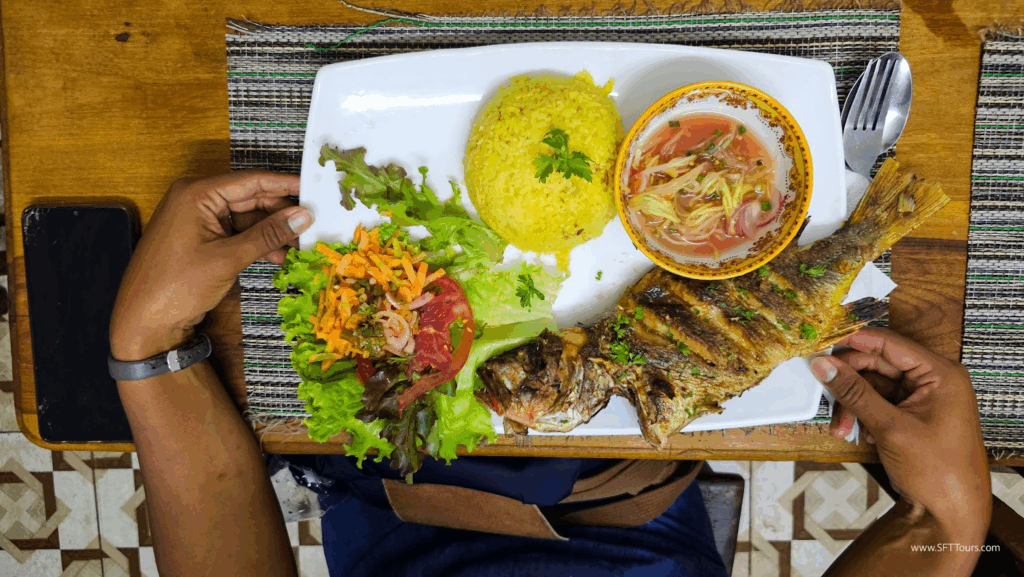
Lasary is a simple side dish that’s either a lightly pickled salad of cabbage, carrots, or green beans, or a sharper version made with green mango, lemon, or cucumbers. Either way, it’s refreshing, crunchy, and zesty, which balances out Madagascar’s heavier rice-based meals.
Street vendors often sell it piled onto baguettes for a quick snack or it is served as a side dish to any protein main.

Romazava is Madagascar’s national dish, a slow-cooked stew, usually made with zebu (local cattle), leafy greens, ginger, garlic, and tomatoes. Malagasy families cook romazava for gatherings, and it’s one of those meals that brings people together around a big pot, everyone spooning from the same steaming bowl. Eat it in a roadside eatery, and you’ll feel the warmth of homestyle cooking; enjoy it in a higher-end restaurant, and you’ll see how it can be refined without losing its soul.
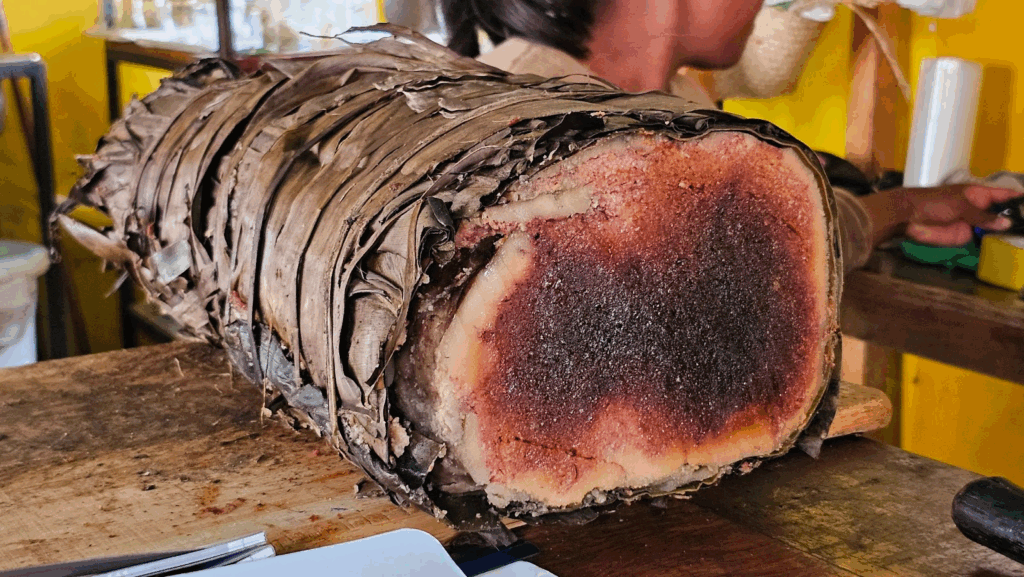
Koba is dessert, but not in the sugary, chocolate-laden way we’re used to in Europe. It’s a dense, nutty cake made from ground peanuts, mashed bananas, and rice flour, all wrapped in banana leaves and steamed until firm.
It’s something between fudge and bread pudding. Street vendors sell it in chunky slices, wrapped and ready to go, so it’s a good snack for travelers.
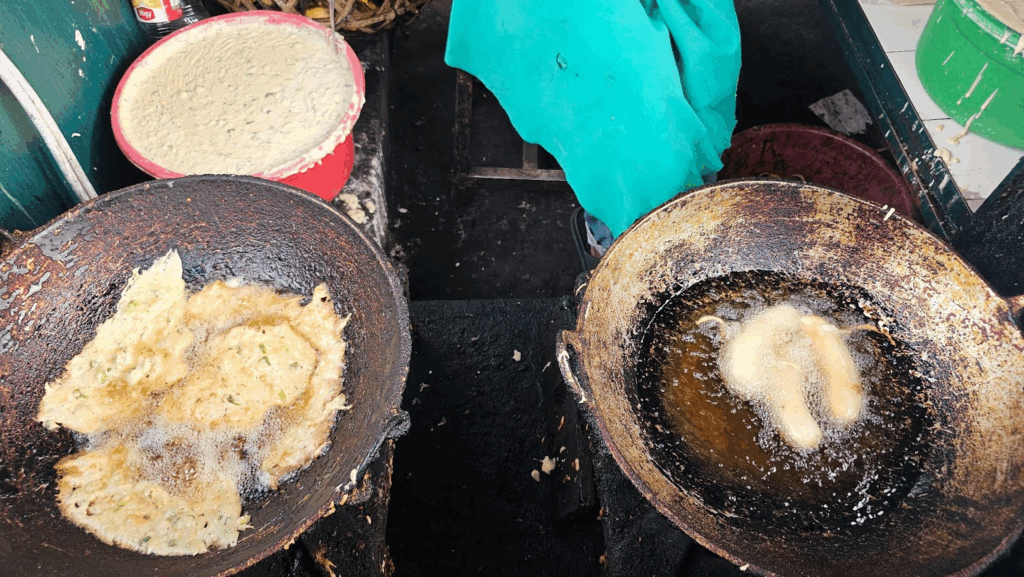
Street snacks including anything that can be deep fried, like bananas, vegetable dough, donuts, etc. are found across the country and a typical mid-day pick me up or even a complete meal for locals.
Best drinks to try in Madagascar
Madagascar has also developed its own range of drinks based on what’s available.

Ranovola (Burnt Rice Water) Ranovola is made by pouring hot water over the toasted layer of rice left at the bottom of a cooking pot. It’s a golden-brown drink with a slightly smoky, nutty flavor.
Locals sip it with meals, often instead of plain water. It sounds odd until you try it! Think of it as Madagascar’s version of a home-brewed herbal tea.
Three Horses Beer (THB) is what you drink if you drink beer. It’s the country’s most popular brew, and you’ll see the green bottles everywhere from beachside bars to tiny roadside kiosks. It hits the spot after a hot day exploring.

Toaka Gasy is Madagascar’s homemade rum, often distilled in villages using sugarcane or fruit. Don’t expect fancy labels or sleek bottles though, this is a rustic, fiery liquor that varies depending on who’s made it. Sometimes it’s flavored with local fruits, spices, or even medicinal herbs. Every visitor who has ever tried it, has described it as “strong”.
Litchel (Lychee Wine) Madagascar grows incredible litchis (lychee), and someone clever figured out how to ferment them into wine. It’s a fruity, slightly sweet wine with a tropical edge, especially popular in the east of the island, which produces a lot of litchis.
Coffee in Madagascar is excellent, but don’t expect a European-style café culture. You’ll get coffee at small roadside stalls or tiny cafés, and it’s served strong, black, often sweetened with a heavy hand of sugar. Milk is rare unless you’re in bigger towns.
The beans themselves are good quality, usually Arabica grown in the highlands, while Robusta dominates the warmer coastal regions (but most of it gets exported). What stays behind is brewed simply, often in dented metal pots, poured into small glasses, and sipped slowly.
Tea in Madagascar is almost as common as coffee, especially in the cooler highlands where a hot drink takes the chill off misty mornings. Black tea dominates, often grown locally and sold loose in markets or in simple bags at roadside shops. Like coffee, it’s usually served sweet, sometimes so sweet it feels more like a dessert than a drink.
Malagasy tea is an easy way to connect with locals. Sit down at a stall, order a glass, and you’ll likely end up in conversation with the person next to you.
Movies about or set in Madagascar
Tabataba (1988) – A powerful Malagasy film that explores the 1947 uprising against French colonial rule through the eyes of a child. It’s raw, emotional, and offers rare insight into the country’s turbulent past.
Quand les étoiles rencontrent la mer (When the Stars Meet the Sea, 1996) – A drama that blends myth and reality, following a boy believed to be cursed. It’s visually striking and deeply tied to Malagasy cultural beliefs.
Madagasikara (2019) – A documentary that pulls back the curtain on poverty, resilience, and hope in Madagascar, told through the stories of local women. It’s eye-opening and grounded in real life rather than tourism gloss.
Madagascar (2005) – Yes, the animated DreamWorks hit with dancing lemurs and city animals escaping to the wild. While not accurate, it did put the island’s name on the global stage and sparked curiosity about the real place.
Books about or set in Madagascar
There are a couple of books worth reading before your trip:
Beyond the Rice Fields by Naivo (2017, English translation) – The first Malagasy novel translated into English, it tells a story of love and slavery in 19th-century Madagascar. It’s a window into a side of history rarely written about.
Return to the Enchanted Island by Johary Ravaloson (2019) – A modern retelling of the epic Malagasy legend of Ibonia, blending folklore with contemporary struggles. It captures both the mythic heart of Madagascar and the challenges of modern identity.
Ibonia (traditional epic, oral literature) – One of Madagascar’s oldest and most famous stories, passed down for centuries. It’s part legend, part adventure, and a key to understanding Malagasy cultural roots.
Poems by Jean-Joseph Rabearivelo (early 20th century) – Often called Africa’s first modern poet, Rabearivelo blended Malagasy and French in works that reflect both colonial tensions and timeless beauty. His words remain some of the island’s most treasured literary contributions.
Ready to travel to Madagascar? Check our women only Madagascar tour itinerary here.
